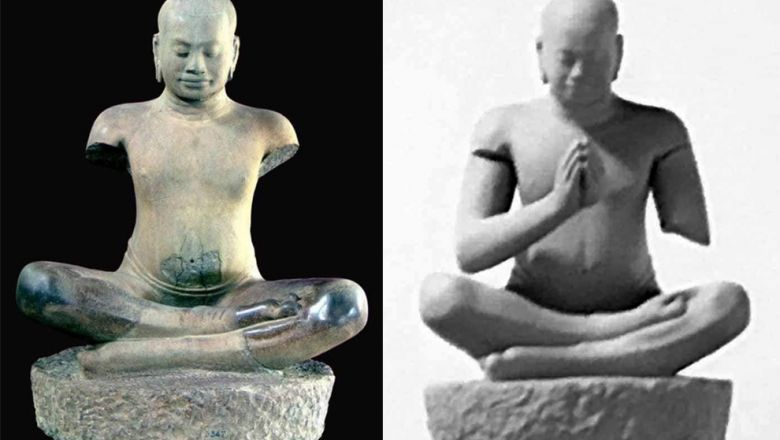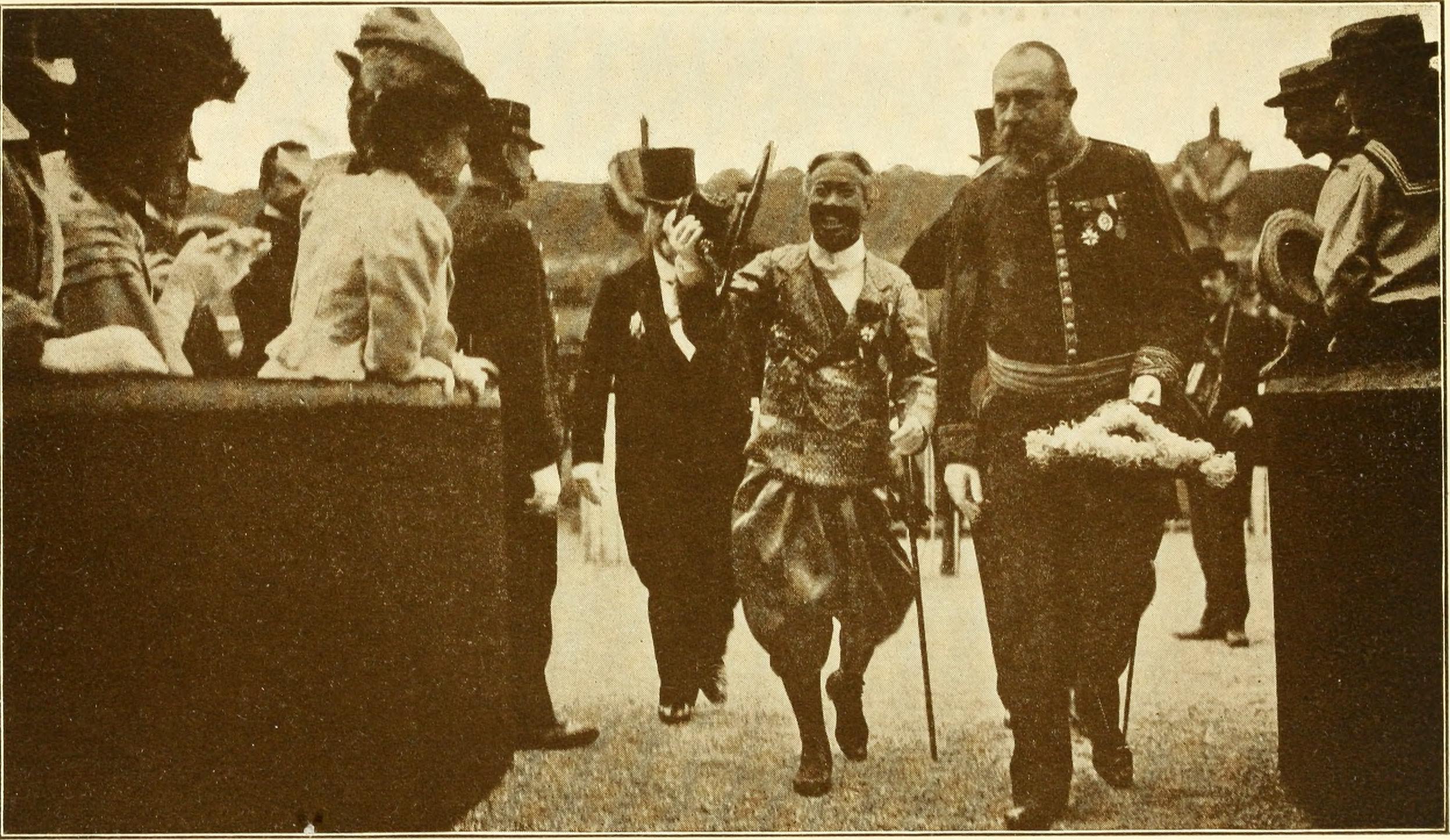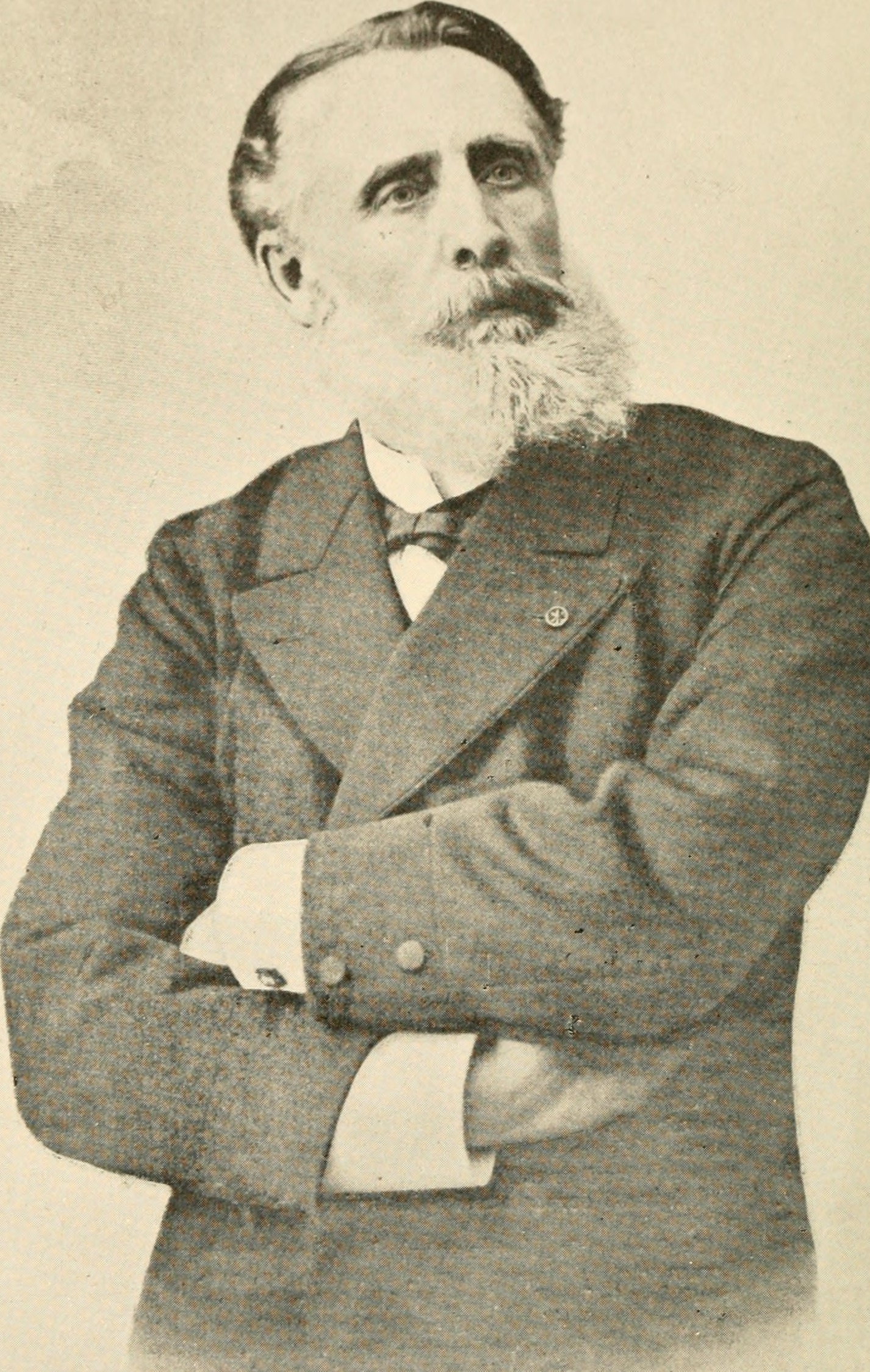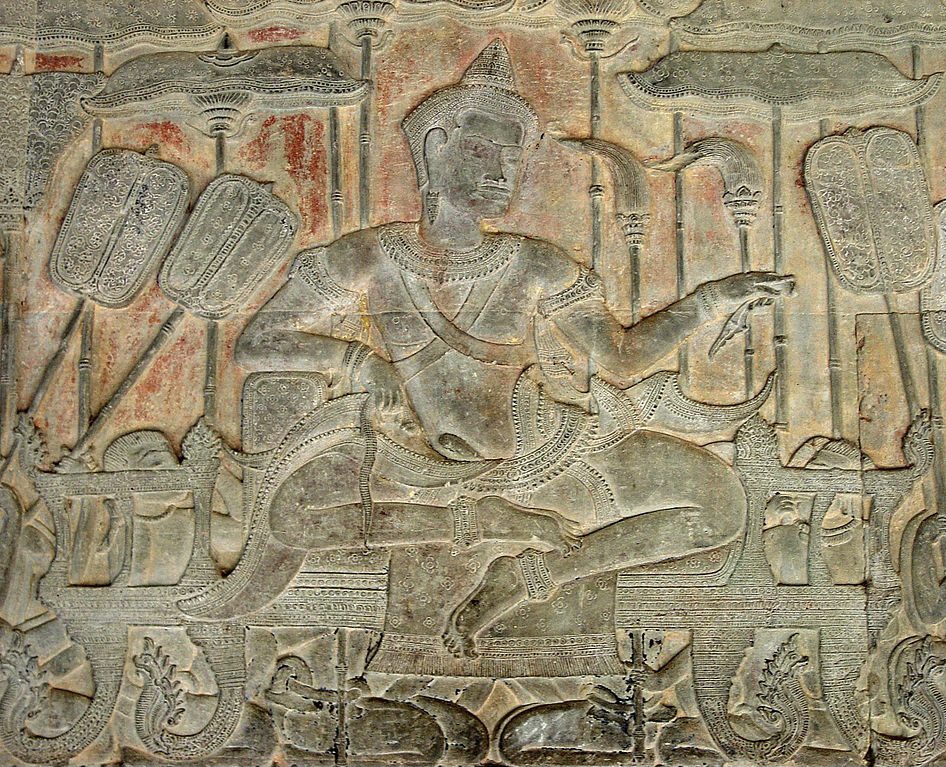|
Bust Of Jayavarman VII
The portrait of Jayavarman VII is a stone bust carved in Angkor during the late 12th or early 13th century representing Jayavarman VII and currently conserved at the Guimet Museum in Paris. It is one of the landmarks of the aesthetics of the Bayon style. Description The bust of Jayavarman VII is a grey-green sandstone head, with downcast eyes and a faint smile. The hairstyle, with the hair pulled into a small round bun at the top of the skull, makes it possible to identify the subject as being a man; the four squatting men sculpted on the pediment of the temple of Banteay Srei, kept at the Guimet museum, have practically the same hairstyle. The square face with full cheeks suggests that the character of Angkor is middle-aged. He wears no adornment and displays a meditative expression. The upper lip, a little longer than the lower lip, seems to protrude slightly; this would make one think that he had his teeth slightly forward, unless this effect is due to the flat mustache whi ... [...More Info...] [...Related Items...] OR: [Wikipedia] [Google] [Baidu] |
Jayavarman VII
Jayavarman VII, posthumous name of Mahaparamasaugata ( km, ជ័យវរ្ម័នទី៧, c. 1122–1218), was king of the Khmer Empire. He was the son of King Dharanindravarman II (r. 1150–1160) and Queen Sri Jayarajacudamani. He was the first king devoted to Buddhism, as only one prior Khmer king was a Buddhist. He then built the Bayon as a monument to Buddhism. Jayavarman VII is generally considered the most powerful of the Khmer monarchs by historians. His government built many projects including hospitals, highways, rest houses and temples. With Buddhism as his motivation, King Jayavarman VII is credited with introducing a welfare state that served the physical and spiritual needs of the Khmer people. Defeat of the Cham and coronation In 1177 and again in 1178, the Cham invaded the Khmer Empire. In 1177, Champa King Jaya Indravarman IV launched a surprise attack on the Khmer capital by sailing a fleet up the Mekong River, across Lake Tonlé Sap, and t ... [...More Info...] [...Related Items...] OR: [Wikipedia] [Google] [Baidu] |
Alfred Foucher
Alfred Charles Auguste Foucher (1865–1952), was a French scholar, who argued that the Buddha image has Greek origins. He has been called the "father of Gandhara studies", and is a much-cited scholar on ancient Buddhism in northwest Indian subcontinent and the Hindu Kush region. Travels He made his first trip to northeastern India in 1895. In 1910 he examined the Great Zimbabwe and the Khami ruins, proclaiming both were made by Phoenicians. His views on ruins in southern Africa are not considered accurate by modern scholars. In 1922 he was asked by the governments of France and Afghanistan to organize an archeological co-operative which became the ''French Archaeological Delegation in Afghanistan (DAFA)''. Foucher's most famous work was ''L'Art Gréco-Bouddhique du Gandhara'' in which he described how Buddhist art prior to Pan-Hellenism was principally aniconic, representing the Buddha by depicting elements of the Buddha's life instead of depicting the Buddha himself. Fouch ... [...More Info...] [...Related Items...] OR: [Wikipedia] [Google] [Baidu] |
Ministry Of Culture And Fine Arts (Cambodia)
The Ministry of Culture and Fine Arts (MCFA; Khmer: ក្រសួងវប្បធម៌ និងវិចិត្រសិល្បៈ) is the government ministry with a mandate to promote, encourage and support the fine arts of Cambodia. See also * Culture of Cambodia * Government of Cambodia External linksMinistry of Fine Arts Government ministries of Cambodia Cambodian culture Cambodia Cambodia (; also Kampuchea ; km, កម្ពុជា, UNGEGN: ), officially the Kingdom of Cambodia, is a country located in the southern portion of the Indochinese Peninsula in Southeast Asia, spanning an area of , bordered by Thailand t ... Phnom Penh Ministries established in 1997 1997 establishments in Cambodia {{culture-ministry-stub ... [...More Info...] [...Related Items...] OR: [Wikipedia] [Google] [Baidu] |
Ta Prohm
Ta Prohm ( km, ប្រាសាទតាព្រហ្ម, UNGEGN: , ALA-LC: ; "Ancestor Brahma") is the modern name of the temple in Siem Reap, Cambodia, built in the Bayon style largely in the late 12th and early 13th centuries and originally called Rajavihara ( km, រាជវិហារ, UNGEGN: , ALA-LC: ; "Royal Monastery"). Located approximately one kilometre east of Angkor Thom and on the southern edge of the East Baray, it was founded by the Khmer King Jayavarman VIIHigham, C., 2001, The Civilization of Angkor, London: Weidenfeld & Nicolson, Higham, C., 2014, Early Mainland Southeast Asia, Bangkok: River Books Co., Ltd., as a Mahayana Buddhist monastery and university. Unlike most Angkorian temples, Ta Prohm is in much the same condition in which it was found: the photogenic and atmospheric combination of trees growing out of the ruins and the jungle surroundings have made it one of Angkor's most popular temples with visitors. UNESCO inscribed Ta Prohm on ... [...More Info...] [...Related Items...] OR: [Wikipedia] [Google] [Baidu] |
Torso
The torso or trunk is an anatomical term for the central part, or the core, of the body of many animals (including humans), from which the head, neck The neck is the part of the body on many vertebrates that connects the head with the torso. The neck supports the weight of the head and protects the nerves that carry sensory and motor information from the brain down to the rest of the body. In ..., limb (anatomy), limbs, tail and other appendages extend. The tetrapod torso — including human body, that of a human — is usually divided into the ''chest, thoracic'' segment (also known as the upper torso, where the forelimbs extend), the ''abdomen, abdominal'' segment (also known as the "mid-section" or "midriff"), and the ''pelvic'' and ''perineum, perineal'' segments (sometimes known together with the abdomen as the lower torso, where the hindlimbs extend). Anatomy Major organs In humans, most critical Organ (anatomy), organs, with the notable exception of the brain, are ho ... [...More Info...] [...Related Items...] OR: [Wikipedia] [Google] [Baidu] |
Philippe Stern
Philippe Stern (11 April 1895 – 4 April 1979) was a French art historian. He worked at the Guimet Museum (1929-1965). Literary works * ''Le Bàyon d'Angkor et l'évolution de l'art Khmer'' (), 1927 * ''L'art du Champa et son évolution'' (), 1942 * ''Colonnes indiennes d' Ajanta et d'Ellora Ellora is a UNESCO World Heritage Site located in the Aurangabad district of Maharashtra, India. It is one of the largest rock-cut Hindu temple cave complexes in the world, with artwork dating from the period 600–1000 CE., Quote: "These 34 ...'' (), 1972 External links * http://angkor.wat.online.fr/dec-stern.htm Trésors d'art du Vietnam, la sculpture du Champa*Rénovation du musée national des Arts asiatiques-Guimet* French art historians French orientalists 1895 births 1979 deaths French Indologists French male non-fiction writers 20th-century French male writers {{France-art-historian-stub ... [...More Info...] [...Related Items...] OR: [Wikipedia] [Google] [Baidu] |
French Protectorate Of Cambodia
The French protectorate of Cambodia ( km, ប្រទេសកម្ពុជាក្រោមអាណាព្យាបាលបារាំង; french: Protectorat français du Cambodge) refers to the Kingdom of Cambodia when it was a French protectorate within French Indochina, a collection of Southeast Asian protectorates within the French Colonial Empire. The protectorate was established in 1863 when the Cambodian King Norodom requested the establishment of a French protectorate over his country, meanwhile Siam (modern Thailand) renounced suzerainty over Cambodia and officially recognised the French protectorate on Cambodia. Cambodia was integrated into the French Indochina union in 1887 along with the French colonies and protectorates in Vietnam ( Cochinchina, Annam and Tonkin). In 1946, Cambodia was granted self-rule within the French Union and had its protectorate status abolished in 1949. Cambodia later gained its independence. The day was celebrated as i ... [...More Info...] [...Related Items...] OR: [Wikipedia] [Google] [Baidu] |
Édouard Marie Heckel
Dr. Édouard Marie Heckel (March 24, 1843 – January 20, 1916) was a French botanist and medical doctor, and director of the Jardin botanique E.M. Heckel in Marseille. Heckel was born in Toulon, studied pharmacy and medicine, and in 1861 visited the Caribbean and Australia. In 1875, he was appointed professor in the faculty of sciences at Marseille, and in 1877 professor of medicine. He became a professor of natural history in Nancy in 1878, and is known for his studies of tropical plants and their use as medicinal plants and oilseeds. From 1885, Heckel turned to the study of tropical plants such as medicinal or industrial oilseeds. In 1893 he founded the Colonial Institute and Museum of Marseille and creates a tropical pathology professorship at the medical school. In 1887, he won the ''Prix Barbier'' from the French Academy of Sciences. In 1896, French botanist Jean Baptiste Louis Pierre named a genus of flowering plants (belonging to the family Meliaceae) from western centr ... [...More Info...] [...Related Items...] OR: [Wikipedia] [Google] [Baidu] |
Brahma
Brahma ( sa, ब्रह्मा, Brahmā) is a Hindu god, referred to as "the Creator" within the Trimurti, the trinity of supreme divinity that includes Vishnu, and Shiva.Jan Gonda (1969)The Hindu Trinity Anthropos, Bd 63/64, H 1/2, pp. 212–226. He is associated with creation, knowledge, and the '' Vedas''. Brahma is prominently mentioned in creation legends. In some '' Puranas'', he created himself in a golden embryo known as the Hiranyagarbha. Brahma is frequently identified with the Vedic god Prajapati.;David Leeming (2005), The Oxford Companion to World Mythology, Oxford University Press, , page 54, Quote: "Especially in the Vedanta Hindu Philosophy, Brahman is the Absolute. In the Upanishads, Brahman becomes the eternal first cause, present everywhere and nowhere, always and never. Brahman can be incarnated in Brahma, in Vishnu, in Shiva. To put it another way, everything that is, owes its existence to Brahman. In this sense, Hinduism is ultimately monotheisti ... [...More Info...] [...Related Items...] OR: [Wikipedia] [Google] [Baidu] |
Guimet Museum
The Guimet Museum (full name in french: Musée national des arts asiatiques-Guimet; MNAAG; ) is an art museum located at 6, place d'Iéna in the 16th arrondissement of Paris, France. Literally translated into English, its full name is the National Museum of Asian Arts-Guimet, or Guimet National Museum of Asian Arts. The museum has one of the largest collections of Asian art outside of Asia. History Founded by Émile Étienne Guimet, an industrialist, the museum first opened at Lyon in 1879 but was later transferred to Paris, opening in the place d'Iéna in 1889. Devoted to travel, Guimet was in 1876 commissioned by the minister of public instruction to study the religions of the Far East, and the museum contains many of the fruits of this expedition, including a fine collection of Chinese and Japanese porcelain and objects relating not merely to the religions of the East, but also to those of ancient Egypt, Greece and Rome. One of its wings, the Panthéon Bouddhique, displ ... [...More Info...] [...Related Items...] OR: [Wikipedia] [Google] [Baidu] |
Neak Ta
A neak ta () is a Cambodian ancestral or tutelary deity, believed locally to watch over people, places, and things, as long as they are paid proper respect. ''Neak ta'' in Khmer translates as the ancestor. A ''neak ta'' can be either feminine or masculine, and most often they operate as a couple. History Origin: an ancestral worship of nature Though the origins of the ''neak ta'' lose themselves in the night of time, they are believed to originate in a certain worship of nature. The cult of the ''neak ta'' may be regarded as a foundational layer upon which later traditions have been overlaid. The cult of the ''neak ta'' contains primitive religious elements, such as lacking dogma and a priesthood, as it preceded both Brahmanism and Buddhism in Cambodia. ''Neak ta'' at Angkor: the influence of the ''devaraja'' In the Angkorian period, the worship of the ''devaraja'' as ''kamraten jagat'', protective genius linked to dynasties and places can be seen as new valorisation of the r ... [...More Info...] [...Related Items...] OR: [Wikipedia] [Google] [Baidu] |
Angkor Wat
Angkor Wat (; km, អង្គរវត្ត, "City/Capital of Temples") is a temple complex in Cambodia and is the largest religious monument in the world, on a site measuring . Originally constructed as a Hindu temple dedicated to the god Vishnu for the Khmer Empire by King Suryavarman II, it was gradually transformed into a Buddhist temple towards the end of the 12th century; as such, it is also described as a "Hindu-Buddhist" temple. Angkor Wat was built at the behest of the Khmer King Suryavarman II in the early 12th century in Yaśodharapura ( km, យសោធរបុរៈ, present-day Angkor), the capital of the Khmer Empire, as his state temple and eventual mausoleum. Angkor Wat combines two basic plans of Khmer temple architecture: the temple-mountain and the later galleried temple. It is designed to represent Mount Meru, home of the devas in Hindu mythology: within a moat more than 5 kilometres (3 mi) long and an outer wall long are three rectan ... [...More Info...] [...Related Items...] OR: [Wikipedia] [Google] [Baidu] |






.jpg)
